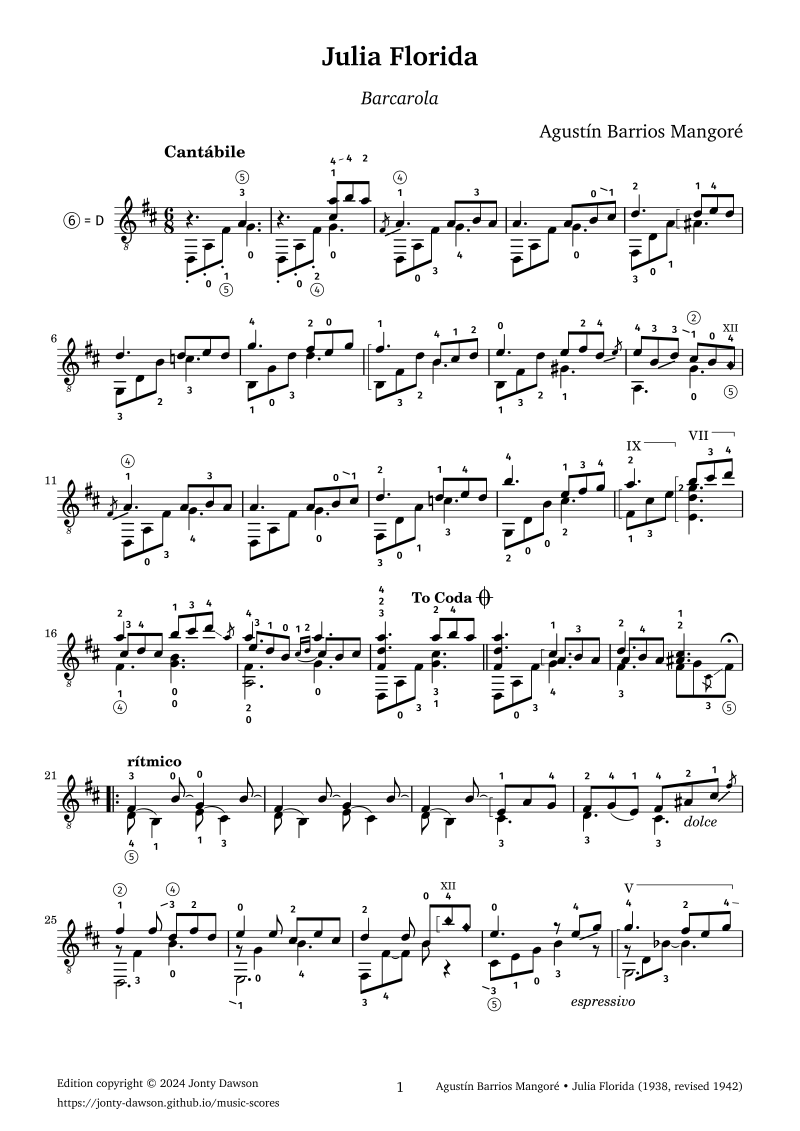Agustín Barrios Mangoré Julia Florida
An edition based on the San Salvador 1942 manuscript.
Sheet music PDF.
Edition notes
There appear to be two manuscripts by Barrios available, but no recording of him playing the piece.
The first manuscript is marked “En San José de Costa Rica. Navidad de 1938.” [Christmas 1938]. It carries the dedication to my intelligent and highly esteemed disciple the distinguished señorita Julia Florida Martinez. Most well-known recordings seem to be derived from this manuscript.
A second manuscript is marked “S.S. (C.A.) 2-X-42” [San Salvador, Central America (El Salvador), 2nd October 1942].
The edition I have put together here is based mostly on the later 1942 manuscript.
The first difference between the sources is in the opening two bar introduction. In MS 1942 we don’t hear the full A7 chord until the second bar, and the rising barcarolle accompaniment is marked staccato, creating contrast with the entry of the melody in bar 3.
In several sections MS 1942 has shorter durations notated in the lower voice compared to MS 1938 - see bars 1-9, 11-15 and 44-47. This might be an intentional thinning and unmuddying of the accompaniment, avoiding swamping the melody above; or perhaps just to simplify notation, with the expectation that the performer would let notes ring (though elsewhere bass note durations are notated precisely as dotted quarter or dotted half notes).
Another change is the reworking of the moody F♯ minor (mediant) passage in bars 40-43, which leads into the most emotionally-wrought phase of the piece. The revised section possibly maintains a bit more forward momentum, steadily building rather than entering a slight lull. Bar 40 keeps the eighth note motion through beats 4-5-6; bars 42 and 43 have an F♯ that holds tension through to the cadence in bar 44, as opposed to MS 1938 where the leading-tone E♯ repeatedly resolves up to the F♯. The revised section puts more emphasis on a G♯, the pivot note in the bar 44 cadence - setting up the subsequent voice leading that descends chromatically through G♮ (bar 45), F♯ and F♮ (bar 46), E (bars 47-53), E♭ (bar 54), D (bar 55) and finally to C♯ (bar 56).
In bars 42 and 43, there is some ambiguity in that the notated pitches of MS 1942 don’t seem to work with the notated left-hand fingering. Bar 42 has lower voice beat 4 (highlighted with asterisk below) as {G♯ 3, B♮ 2} - which doesn’t make sense with the 4th-fret barre (B natural would be with the barre / 1st finger). Perhaps this is a mistake in fingering notation, or else an accidental sharp is missing and {G♯ 3, B♯ 2} was intended?
Bar 43 is difficult to make out in the low-res image. I read this as Barrios, having run out of space for fingering directly to the left of the B notehead, has written the “2” lower down along with a short looping line to indicate it is intended for the B. There is no sharp sign on the G, but this could be in error - Barrios often adds cautionary accidentals (for example, see G♮ in bar 45), so we might expect an explicit natural sign if G♮ was intended? As with bar 42, the fingering doesn’t make sense for the literally notated pitches {G♮ 3, B♮ 2} with a 4th-fret barre.
I appreciate that this is only a small detail, not something to get too hung-up about, but I have found it intriguing to explore the alternatives a bit further.
Harmonically, MS 1938 in bars 42 and 43 implies F♯m / C♯7.
In MS 1942, we have F♯m followed by either C♯7sus4 for {G♯, B♮}; or the more mysterious-sounding G♯7no5 for {G♯, B♯}.
Either way, we are setting up an expectation that the high sustained F♯ will fall down to E♯, which is what occurs in bar 44 with the French 6th → dominant resolution: D7♭5 (respelled, tritone substitution for G♯7) → C♯. With the {G♯, B♯} choice, all notes of G♯7no5 are present in D7♭5, creating a kind of anticipation that I find effective.
I did a brief YouTube trawl for recordings that sound as if they are derived from MS 1942 (some play the intro as MS 1938). In each, the guitarist is playing {G♯, B♮}.
Clearly there is an established performance tradition of playing {G♯, B♮} - unsurprisingly since those are the literally notated pitches. However, I have come to prefer playing {G♯, B♯}, and since I am just some guy who doesn’t know any better, that is what I’ve gone with for this edition! I’ve included a footnote to alert the unwary.
Some other edits:
- Bar 10 open G for full dotted quarter note, similar to MS 1938.
- Bar 30 played at position II.
- Bar 39 portamento C♯ → A on string ③ rather than ④.
- Fingering changes elsewhere - usually because I find it more reliable, and the change doesn’t affect timbre too much. For example no barre at bars 18, 57; open G bar 30.
- Beaming and voice edits, mostly to avoid mixing open noteheads with beamed stems. For example bars 25-56, 29, 48, 50, 52.
Links
Julia Florida 1938 manuscript - I don’t know if it is published elsewhere, but this Twitter post by Tony Morris, Oct 11, 2019 has photos. [Page 1] [Page 2].
Julia Florida 1942 manuscript is available on IMSLP.
An edition by Stefan Apke also showing the possible choice of {G♯, B♯} in bar 42.
Other editions on IMSLP.
Richard Stover talks about meeting Julia (Florida) Martinez de Rodriguez.
Edition summary
| Title | Julia Florida |
| Composer | Agustín Barrios Mangoré |
| Instrument | Guitar |
| Editor | Jonty Dawson |
| Edition date | 2024-01-12 |
| Page count | 2 |
| Edition PDF | barrios-agustin-julia-florida-guitar.pdf |
| Video | https://youtu.be/kVn6imVC6Ww |

